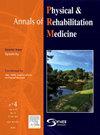Hip disability and Osteoarthritis Outcome Score trajectories and prognostic factors for functional decline: A 3-year follow-up study
IF 4.6
3区 医学
Q1 REHABILITATION
Annals of Physical and Rehabilitation Medicine
Pub Date : 2025-02-01
DOI:10.1016/j.rehab.2024.101893
引用次数: 0
Abstract
Background
Hip osteoarthritis (OA) can cause pain, restricted locomotor activity and functional impairments but it remains difficult to predict functional decline over time.
Objectives
The aims of this study were to identify functional decline trajectories in people with hip OA using the Hip disability and Osteoarthritis Outcome Score (HOOS) domains and to determine radiological and gait predictors of typical trajectories.
Methods
Consecutive people with hip OA with no indication for total hip replacement at baseline were included. Radiological, clinical (HOOS) and gait analyses were collected at baseline, and clinical follow-up was carried out every 6 months for 3 years. HOOS trajectories were estimated by group-based trajectory modeling. Predictive factors were identified by multivariate logistic regression, and their discriminatory power was assessed using the area under the ROC (receiver operating characteristic) curve.
Results
Two distinct trajectories were highlighted for all HOOS domains: Traj1 (progressor) and Traj2 (non-progressor). Using a multivariate analysis, gait speed was found to be predictive of Traj1 for HOOS symptoms/stiffness (odds ratio [OR] 0.61, 95 % CI 0.45 to 0.83, AUC (area under the curve) = 75 %) and for HOOS pain (OR = 0.72, 95 % CI 0.53 to 0.97, AUC = 72 %). Moreover, maximum hip extension was found to be predictive of Traj1 for HOOS sports and leisure (OR = 0.78, 95 % CI 0.69 to 0.89, AUC = 81 %) and HOOS quality of life (OR = 0.84, 95 % CI 0.73 to 0.95, AUC = 66 %).
Conclusion
This study identified 2 typical trajectories of functional decline (progressor/non-progressor) for the 5 HOOS domains. It also demonstrated the predictive validity of 2 gait parameters (gait speed and maximum hip extension) for functional decline.
Database registration
NCT02042586
髋关节失能和骨关节炎预后评分轨迹和功能衰退的预后因素:一项为期3年的随访研究。
背景:髋关节骨关节炎(OA)可引起疼痛、运动活动受限和功能损伤,但随着时间的推移,其功能衰退仍难以预测。目的:本研究的目的是利用髋关节残疾和骨关节炎结局评分(HOOS)域确定髋关节骨性关节炎患者的功能衰退轨迹,并确定典型轨迹的放射学和步态预测因子。方法:连续纳入基线时无全髋关节置换术指征的髋关节OA患者。基线时收集影像学、临床(HOOS)和步态分析,每6个月进行一次临床随访,持续3年。采用基于群的轨迹建模方法估计hos轨迹。采用多变量logistic回归确定预测因素,并采用受试者工作特征曲线下面积评估其判别能力。结果:所有HOOS结构域都强调了两个不同的轨迹:Traj1(进展者)和Traj2(非进展者)。通过多变量分析,发现步态速度可预测Traj1对HOOS症状/硬度(比值比[OR] 0.61, 95% CI 0.45至0.83,曲线下面积(AUC) = 75%)和HOOS疼痛(OR = 0.72, 95% CI 0.53至0.97,AUC = 72%)。此外,最大髋关节伸展被发现可预测HOOS运动和休闲(OR = 0.78, 95% CI 0.69至0.89,AUC = 81%)和HOOS生活质量(OR = 0.84, 95% CI 0.73至0.95,AUC = 66%)的Traj1。结论:本研究确定了5个HOOS结构域的2种典型功能衰退轨迹(进展性/非进展性)。它还证明了2个步态参数(步态速度和最大髋关节伸展)对功能衰退的预测有效性。数据库注册:NCT02042586。
本文章由计算机程序翻译,如有差异,请以英文原文为准。
求助全文
约1分钟内获得全文
求助全文
来源期刊

Annals of Physical and Rehabilitation Medicine
Medicine-Rehabilitation
CiteScore
7.80
自引率
4.30%
发文量
136
审稿时长
34 days
期刊介绍:
Annals of Physical and Rehabilitation Medicine covers all areas of Rehabilitation and Physical Medicine; such as: methods of evaluation of motor, sensory, cognitive and visceral impairments; acute and chronic musculoskeletal disorders and pain; disabilities in adult and children ; processes of rehabilitation in orthopaedic, rhumatological, neurological, cardiovascular, pulmonary and urological diseases.
 求助内容:
求助内容: 应助结果提醒方式:
应助结果提醒方式:


